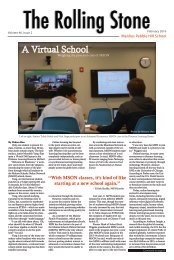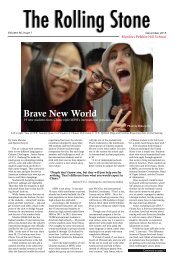Create successful ePaper yourself
Turn your PDF publications into a flip-book with our unique Google optimized e-Paper software.
6<br />
Features<br />
Let’s Taco ‘Bout It<br />
Story by Chenoa Baker and Anna Barnard<br />
MPH lunch staff is served with challenges<br />
Photos by Maddy Rieks<br />
From left to right: Cindy Parody, Trish Etter, Mary Judd, Sonya Mattice<br />
Mary Judd and her crew arrive<br />
at the Manlius Pebble Hill lunch<br />
room at 5:30 a.m. Every day, they<br />
wash tables, prepare the soups and<br />
entrees of the day, slice fresh items for<br />
the deli bar, make breakfast and prepare<br />
salads.<br />
Then, they watch more than 500<br />
students and faculty members flood<br />
the cafeteria to eat the food they prepared.<br />
This daily routine is what the<br />
kitchen staff goes through every day<br />
to prepare snack (breakfast) at 9:30<br />
a.m. and food for three lunch periods.<br />
The lunch staff at MPH works hard<br />
to provide students with lunch, snack,<br />
and the occasional dessert.<br />
Students don’t understand the challenges<br />
that the lunch staff faces trying<br />
to please so many people on a budget,<br />
while making sure that the food<br />
is healthy.<br />
“Mary pays meticulous attention<br />
each day to providing [520] people<br />
with not only a nutritionally-balanced<br />
meal, but one that accommodates<br />
dietary restrictions such as nut-free,<br />
gluten-free and vegetarian,” said<br />
Amy Critz, Assistant to the Head of<br />
School, in an email.<br />
The first challenge for the dining<br />
hall staff is staying on budget.<br />
The overall food budget for <strong>2015</strong> is<br />
$339,404, but that breaks down to a<br />
little less than $4.00 per person per<br />
day. Although lunch is included in<br />
tuition, most students don’t know the<br />
cost of their meals. This budget includes<br />
paying for labor, utensils, beverages,<br />
salad bar, hot meals, deli bar,<br />
condiments, and upkeep for the dining<br />
hall.<br />
Judd compared the cost of MPH’s<br />
lunch to a McDonald’s kid’s meal.<br />
A McDonald’s Mighty Kids Meal<br />
costs $3.99 for six-piece chicken nuggets,<br />
fries, apple slices or yogurt and a<br />
drink (not including tax).<br />
“So you have to realize that I put<br />
out cereal, milk, juice, yogurt, all of<br />
this food and it’s less than what you<br />
could get a Happy Meal for at Mc-<br />
Donald’s,” she said. “So it’s kind of<br />
hard to... I mean I like to be fancy<br />
when I can, but I have to stay within a<br />
budget, so you know even at $4 a head<br />
you really can’t go out and buy much<br />
with that.”<br />
The second challenge is to provide<br />
healthy meals at MPH. With<br />
childhood obesity on the rise, school<br />
lunches have long been criticized for<br />
their content. Schools that participate<br />
in the National School Lunch Program,<br />
and therefore receive federal<br />
money toward their lunch expenses,<br />
must now follow the guidelines set by<br />
the Healthy, Hunger-Free Kids Act,<br />
championed by Michelle Obama and<br />
passed into law in 2010. The new law<br />
required schools to begin phasing in<br />
healthier snack and lunch options in<br />
2012, including whole grains, low-fat<br />
milk and more fruits and vegetables.<br />
It also set limits on fat, sugar and sodium<br />
contents.<br />
MPH participated in the National<br />
School Lunch program from 2000 to<br />
2012, according to Tara Webster of<br />
the New York Child Nutrition Program<br />
Administration in the state<br />
education department. The school<br />
stopped participating as the new regulations<br />
for lunch content were being<br />
rolled out.<br />
Though the new school lunch standards<br />
have come under attack, a study<br />
by the Harvard School of Public<br />
Health reports that fruit and vegetable<br />
consumption has increased since the<br />
new standards. While students have<br />
long thrown away fruits (40 percent)<br />
and vegetables (75 percent), the study<br />
finds that fewer vegetables were discarded<br />
after the change (down to 60<br />
percent).<br />
A different study done by the<br />
School Nutrition Association, however,<br />
found that 80 percent of schools<br />
(out of 240 districts that participated)<br />
reported more lunch waste since the<br />
changes.<br />
Though MPH does not currently<br />
have to follow any regulations,<br />
the cooking staff strives to provide<br />
healthy meals for the students. But<br />
whether students eat it or not is up to<br />
them.<br />
“Nobody really wants to be forced<br />
into something they really don’t<br />
want,” Judd said. “I really think that<br />
especially today’s children, they want<br />
choices and they’re pretty mature<br />
thinkers nowadays, so I think they<br />
have the right to.”<br />
Theresa Shepherd, an oncology<br />
dietitian, agrees that healthy options<br />
may not always be chosen. Her son<br />
attends East Syracuse-Minoa schools.<br />
“[I am] not thrilled with the school<br />
lunches,” Shepherd said. “Parents<br />
have no control over what their children<br />
choose. I give [my son] money<br />
every day to buy lunch. They offer<br />
veggies and fruits, but also pizza. I’m<br />
not a big fan of having cheese burgers<br />
and chicken fingers every day. I<br />
would love to see salad bars at all of<br />
the schools, but it may not be financially<br />
feasible.”<br />
The fourth challenge at MPH is<br />
to make meals that appeal to the<br />
tastes of so many. Although many<br />
students aren’t aware how the budget<br />
is stretched they have praised the<br />
school lunch for its diversity, varying<br />
choices and healthy options. In a random<br />
survey of students and teachers<br />
conducted by MPH’s <strong>Rolling</strong> <strong>Stone</strong>, it<br />
was found that the MPH school lunch<br />
was rated six or seven out of ten. The<br />
survey found that students preferred<br />
MPH’s school lunch compared to the<br />
public school lunches they’ve had.<br />
“There’s a lot of varying food<br />
choices so on different days we have<br />
different options,” said sophomore<br />
Amina Kilpatrick, who used to attend<br />
Jamesville-DeWitt Elementary<br />
School.<br />
Additionally, Judd tries to accommodate<br />
dietary restrictions by offering<br />
nut-free, gluten-free and vegetarian<br />
options. With all these challenges,<br />
she makes a weekly menu that a lot of<br />
students appreciate. Judd welcomes<br />
communication with the students because<br />
she wants school lunch to be enjoyable.<br />
She wants a relationship with<br />
the students and wants the students to<br />
feel comfortable talking to her about<br />
any ideas, problems and requests.<br />
“My main challenge,” Judd said,<br />
“is making healthy meals that the majority<br />
of the people will eat and like.”






